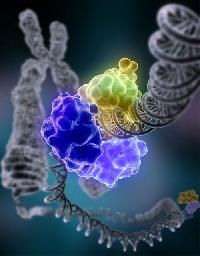
Zinc Finger Nuclease that Disables CCR5 Gene May Offer Potential New HIV Treatment Approach
It
may be possible to create CD4 cells that are resistant to HIV infection by using
zinc finger protein nucleases to disable the gene that encodes the CCR5 co-receptor,
according to research presented at the 48th International
Conference on Antimicrobial Agents and Chemotherapy (ICAAC 2008) last month
in Washington, DC. Michael Holmes of Sangamo BioSciences and colleagues developed zinc finger protein nucleases (ZFNs) that target the CCR5 gene and cause double strand breaks at a predetermined sites in the DNA. Natural DNA repair mechanisms can then be usurped to imperfectly mend these breaks, resulting in the permanent disruption of the gene. ZFNs
were introduced into human cells using an adenovirus vector. Cell-based assays
revealed that the CCR5 ZFNs produced the expected DNA breaks, leading to efficient
gene disruption (> 50%) in human CD4 cells. "These data demonstrate that ZFN-treated cells can be permanently modified to prevent [CCR5]-dependent HIV infection," the researchers concluded. In laboratory cultures and in immunodeficient mice, the modified CD4 cells survived and replicated well in the presence of HIV. Mice that received ZFN-modified cells had increased numbers of CD4 cells and a statistically significant 7-fold reduction in peripheral blood HIV viral load, compared to mice given non-modified cells. Furthermore, the ZFN-altered cells appeared to have a selective advantage relative to unmodified cells. These results led the investigators to suggest that "these cells may be able to reconstitute immune function in patients with HIV/AIDS via maintenance of an HIV-resistant CD4 population." Therapy using this method would involve removing some CD4 cells from a patient, modifying them in the laboratory, and returning them to the body, where they would hopefully replicate to create a reservoir of protected, HIV-resistant cells, thereby preserving immune function. By permanently modifying cells so they cannot express CCR5, the zinc finger approach has a potential advantage over small molecule CCR5 antagonists or antibodies such as PRO 140 that must be continually administered to block the co-receptor and prevent HIV entry. The zinc finger method would only alter CCR5 expression on CD4 cells -- not other cell types -- but it is not yet clear whether disrupting CCR5 expression could have unknown detrimental effects on immune function. "We
are very excited about these data and our collaboration with Sangamo to develop
an HIV/AIDS therapeutic," said Carl June, MD, of the University of Pennsylvania
School of Medicine in a press release issued by the company. "The ability
to prevent immune cells from becoming infected by HIV has the potential to provide
long term control of both the opportunistic infections characteristic of AIDS
as well as the virus itself. We look forward to bringing this program into the
clinic." |
The
material posted on HIV and Hepatitis.com about ICAAC 2008 and IDSA 2008 is not
approved by nor is it a part of ICAAC 2008 or IDSA 2008. |
![]()
